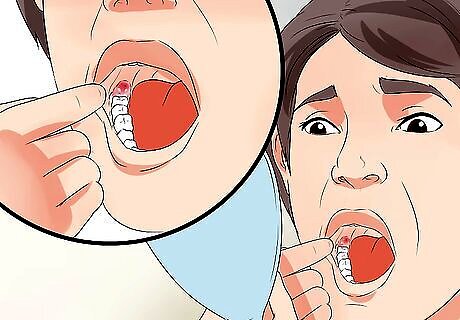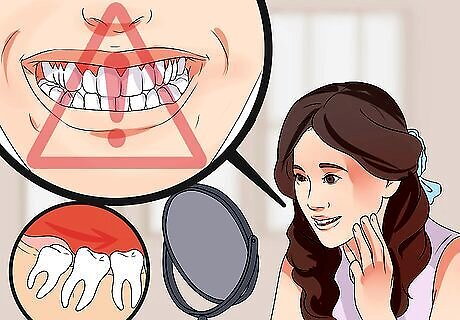
views
X
Research source
They are the last teeth to erupt in your mouth, which typically happens during the late teenage years or early twenties. Wisdom teeth often erupt through the gums without any symptoms, but sometimes the process can cause pain or tenderness — particularly if there isn't enough space for them in the mouth or if they grow at odd angles. If you feel your wisdom teeth coming in, then you may need to see a dentist to make sure there's no potential issue.
- Watch for mild pain or pressure along your gums and jaw. This might be your wisdom teeth trying to erupt.
- Look out for red, swollen gums towards the back of your jaw that make it difficult or uncomfortable to chew.
- Check if your teeth are starting to twist or turn crooked. This might be your wisdom teeth crowding your other teeth.
Early Symptoms

Don't always expect symptoms. If wisdom teeth fully erupt (come in) through the gums straight, well-spaced and positioned properly in relation to other teeth, then they often cause no pain or inflammation and don't need to be removed. According to board-certified dentist Alina Lane, many people are born without any wisdom teeth. It's only when these teeth partially erupt, lack enough space, grow crooked and/or create a risk of infection that they become problematic and need to be removed. Wisdom teeth don't fully erupt in everyone. Sometimes they remain completely hidden within the gums and bone, or they may only partially erupt. The American Dental Association recommends that people between 16–19 years old get their wisdom teeth evaluated by a dentist. The longer your wisdom teeth stay in your mouth after the age of 18, the more developed the roots become, making them more difficult to remove if they are problematic.

Look out for gum or jaw pain. Even wisdom teeth that erupt normally through your gums can cause mild symptoms. Look for mild pain, a feeling of pressure, or dull throbbing in the gums near the opening of your throat or in the nearby jaw bone. Erupting teeth can irritate the sensitive tissues that make up your gums (called gingiva). The pain will be more severe if the wisdom teeth are crowded and grow crookedly — they can cut into delicate gum tissues. Pain is subjective — mild pain for some, might be intolerable for others. The point is, some pain can be entirely normal for erupting wisdom teeth, so give it some time (at least a few days) before seeing your dentist. Eruption of wisdom teeth is not continuous, so every three to five months you may experience the same pain for a few days. The wisdom tooth eruption influences the bone position of the other teeth so you may find that your teeth begin to shift. If the wisdom teeth are not able to erupt normally, they may become trapped or impacted within your jawbone. This increases the risk of infection (see below). The pain from erupting wisdom teeth can get worse at night if you have a habit of clenching your jaw and/or grinding your molars. Chewing gum may also aggravate the pain caused by wisdom teeth. While the pain typically goes away without professional intervention, there are a variety of ways to help ease the pain for you to try in the meantime.

Watch for redness and swelling. Wisdom teeth can also trigger redness and swelling (inflammation) in the gingiva. You may be able to feel the swollen gums with your tongue. They make it more difficult or uncomfortable to chew food while inflamed. Take a small penlight and shine it into your mouth while looking in a mirror. Wisdom teeth are the very last teeth (most posterior) in each row. Look for the top of the teeth (cusps or crown) poking through the gums and see if the tissue looks redder or swollen (called gingivitis) than other areas. The swelling usually goes away after a week or so. While looking in your mouth, you might see some blood around the protruding wisdom tooth, or your saliva may be tinged red. This is relatively uncommon, but not rare. Other causes of blood can include gum disease, canker sores or mouth trauma. You might see a "gum flap" over your erupting wisdom tooth, which is known as a pericoronal flap. This is normal and doesn't usually cause any problems. While your rear gum tissue (gingiva) is swollen, it might be difficult to open your mouth. You may need to drink fluids through a straw for a few days. You may also find it difficult to swallow. Your dentist may prescribe some anti-inflammatory medication for you to take for a few days. Lower wisdom teeth are close to your tonsils, which may swell, giving you the feeling of getting a cold or sore throat.
Later Symptoms

Be on the alert for an infection. According to board-certified dentist Alina Lane, impacted wisdom teeth can lead to infection, especially if the gum tissue is pocketed around the tooth. Common signs of an infected wisdom tooth include: considerable gum swelling, severe pain, sore or bleeding gums, problems opening your mouth, bad breath, and an unpleasant taste in your mouth. The type of pain associated with an infected wisdom tooth is often a constant dull ache combined with infrequent sharp and shooting pains. Pus is a grayish-white color and made from white blood cells of the immune system. These specialized cells rush to the infection site to kill bacteria, then they die and form pus. Bad breath can also be caused by trapped and rotting food underneath pericoronal flaps.

Check your front teeth for crookedness. Board-certified dentist Alina Lane notes that even if your wisdom teeth grow in crooked and become impacted within your jaw bone, they may not cause pain and other noticeable symptoms. However, with some time (even just a few weeks), they often start to crowd other teeth and push them out of alignment. This "domino effect" can eventually affect your teeth that are visible when you smile, making them twisted or crooked looking. If you think your front teeth are suddenly getting crooked or twisted, compare your current smile to older photographs. If your wisdom teeth are pushing others too far out of place, your dentist may recommend you have them removed. Once wisdom teeth are removed (extracted), other crooked teeth can slowly become realigned again naturally after a few weeks or months.

Chronic pain and swelling is not normal. Although some short-term tolerable pain and inflammation is normal with erupting wisdom teeth, chronic (long-term) pain and swelling is not. Wisdom teeth that fully grow in above the gum line don't usually cause much pain or swelling beyond a few weeks. Severe pain and inflammation that lasts for more than a few weeks is more common with impacted wisdom teeth that remain in the jaw bone. Impacted wisdom teeth that lead to severe and/or chronic symptoms should be removed. People with small jaws and mouths are much more likely to have impacted wisdom teeth that cause significant pain and swelling. Although impacted wisdom teeth might not directly cause symptoms, they can promote decay in other teeth or surrounding gum tissue that can lead to long-term pain. Deciding when to go to the dentist depends on your pain tolerance and ability to be patient. As a general rule, if the pain keeps you from getting sleep (without medication) for more than three to five days, then it's best to get your teeth checked out.
Managing Symptoms

Massage your gums with your finger or some ice. Gently massaging a clean (sanitized) finger back and forth or in small circles over your tender gums can provide temporary relief. Be careful not to rub too hard because you could disrupt or damage the pericoronal flap and trigger more irritation, swelling and/or bleeding. If you can tolerate it, use a small ice cube to combat inflammation and dull the pain. The ice will feel shockingly cold initially, but the tissue around the erupting wisdom tooth should get numb within five or so minutes. You can use ice three to five times daily or as needed to deal with tenderness. Make sure to trim your fingernails and sanitize your finger with alcohol wipes in order to prevent transferring bacteria onto your gums. You can make an infected wisdom tooth worse if you don't practice good hygiene. Ask your dentist if he can recommend a desensitizing cream or ointment that you can massage into your inflamed gums. Using cold compresses and sucking on frozen treats (Popsicle, sorbet or ice cream) may also help soothe tender gums.

Take over-the-counter (OTC) anti-inflammatories or painkillers. Ibuprofen (Advil, Motrin) is a good anti-inflammatory that can combat pain and swelling associated with a symptomatic wisdom tooth. Acetaminophen (Tylenol) is a good painkiller and a strong antipyretic, which means it can fight a fever, but it doesn't impact inflammation. The maximum daily dosage of ibuprofen and acetaminophen for adults is about 3,000 mg, but always read the directions that come with medications. Taking too much ibuprofen (or taking it for too long) can irritate and damage the stomach and kidneys, so take the medication with food. Taking too much acetaminophen is toxic and damaging to the liver. Alcohol should never be combined with acetaminophen.

Use antiseptic mouthwash. Using an antiseptic or antibacterial mouthwash can help treat or prevent infections and pain in the gums and teeth. Mouthwashes with chlorhexidine, for example, can help to both relieve swelling and pain, and keep your mouth free of infection. Ask your dentist or pharmacist for OTC recommendations. Whichever brand you choose, hold it in your mouth for at least 30 seconds and try to swish it around the back of your mouth where the erupting wisdom teeth are. Swishing around the pericoronal flaps may also help remove any trapped food, plaque or debris. Make a natural and inexpensive antiseptic mouthwash by adding a half-teaspoon of table salt or sea salt to a cup of warm water. Gargle for 30 seconds, then spit and repeat three to five times daily or as needed. Gargling with diluted vinegar, fresh lemon juice, diluted hydrogen peroxide or with a few drops of iodine in water are all effective for combating infections in your mouth. Wormwood tea is also a great adjuvant that helps gums fight with the inflammatory process.


















Comments
0 comment